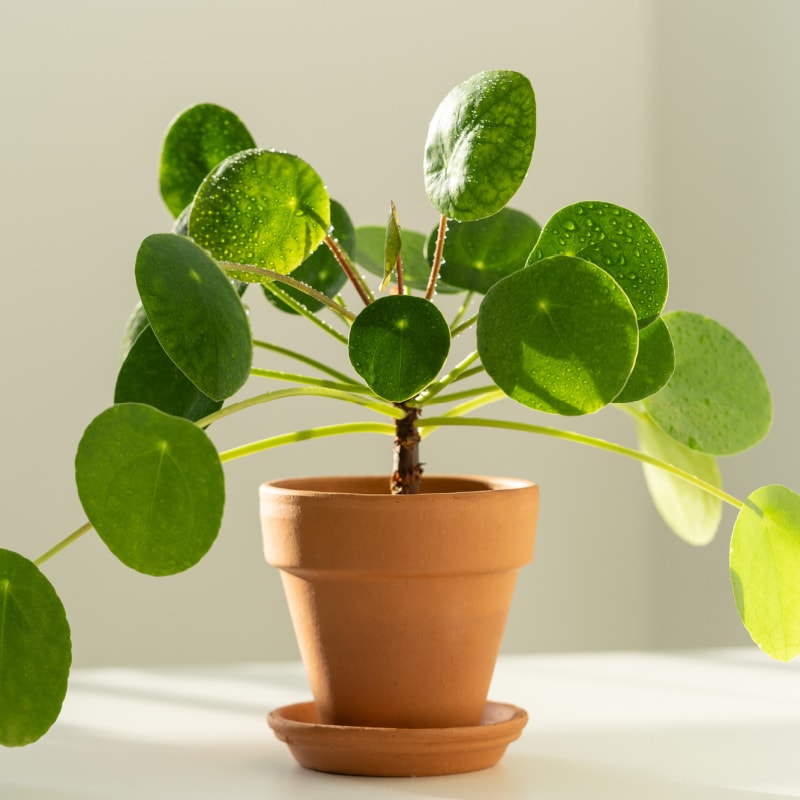Chinese Money Plant
The Chinese Money Plant, also known as the Friendship Plant or Pilea peperomioides, is a popular houseplant that is known for its round, bright green leaves. If you’re looking for a plant that is both easy to care for and unique, the Pilea is a great option!
The Chinese Money Plant, is a beautiful houseplant that’s easy to care for. If you’re looking for a plant that will thrive indoors and add a touch of green to your home, this Pilea Peperomioides is a great option.
Keep reading to learn everything you need to know about how to grow and care for a Pilea plant.

This post contains affiliate links. If you make a purchase after clicking a link I may make a small commission at no added cost to you.
More names for this plant are: the pancake plant, coin plant, pass along plant, or UFO plant
Caring for Chinese Money Plants
Chinese Money plant (pilea peperomioides) is native to the Yunnan Province of China. They prefer warm temperatures and moderate humidity levels, so if you live in a dry climate, you may need to use a few tricks to keep your Pilea plant happy.
Here are some tips for growing and caring for your Pilea plant:
Light and Temperature
Pileas enjoy bright, indirect light and prefer temperatures between 60-85 degrees Fahrenheit. If your home is on the cooler side, you can try growing your Pilea near a south-facing window.
But typically near a north or east-facing window is perfect. At temperatures below 55 degrees your Chinese Money plant may look a bit sad as it prefers warmer temps.
Rotate your plant when a 1/4 to 1/2 turn when you water, this helps it growing upright rather than leaning towards the light source.
Protect it from drafts, air conditioning vents, open windows and heat vents. Also if the micro-climate near the windows is chilly in winter move it further into the room.

Leaves may need to be wiped regularly with a damp cloth. This will remove dust that accumulates that can inhibit photosynthesis and your money plant will behave as though it is not getting enough light.
How to Water Pileas
Chinese money plants enjoy good drainage and a bit of drying out between waterings.
Allow the top couple of inches of soil to dry out before watering again. I find watering once a week works and I use a moisture meter like this one before watering to be sure it needs it.
Overwatering that leads to root rot is one of the most common problems with indoor plants, so err on the side of caution when it comes to watering your houseplants.
Fertilizing
Chinese Money plants don’t need much fertilizer, but if you want to give yours a little boost, many suggest using a half-strength liquid balanced fertilizer once a month during the growing season (spring and summer).
I use grow lights for many of my houseplants and this fools the plants into thinking it is spring and summer so I continue feeding during the winter too.
I prefer to feed my plants weekly so I dilute the plant food to 1/8. (do you remember dividing fractions in school?.. here is where that math class comes in handy)
My reasoning is that in nature plants do not get fed intermittently but consistently and my goal is to mimic that. This organic fertilizer works wonders, it is also what I use on my outside plants so I don’t need a different fertilizer. (the affiliate link will get you a 5% discount)
I use the General Purpose on indoor plants that don’t flower but my Pelargoniums (Zonal Geraniums) that I keep inside under grow lights I feed with the Fruit and Flower.
Best Soil for Chinese Money Plant
I have found that most houseplants available at garden centers come in a peat moss based soil or medium that holds too much moisture for these plants to thrive. Pileas are related to succulents and need really good drainage.
(Yes, they are considered a succulent under the definition of a plant that stores water in its leaves.)
So the best thing to do is let it acclimate to your home for a couple of weeks then repot into the same size pot.
If roots are showing through the bottom of the pot your Chinese Money plant has outgrown its current pot.
Choose a new pot that is two inches wider in diameter than the current pot. Make sure there are drainage holes in the bottom.
I prefer terra cotta pots many times but plastic pots or glazed ceramic work well too.
The best potting soil is any good quality potting soil with a bit of added horticultural sand or perlite (if I have it on hand I have switched to rice hulls instead of perlite, more environmentally friendly)
lots of plants?
Make Your Own Potting Soil
Recipes for creating your own DIY potting soil for houseplants, succulents, and more!
How to Repot Your Chinese Money Plant
Being a fast-growing plant they can quickly outgrow their pots. Here’s a step-by-step guide to help you repot your Chinese money plant.
- Water your plant thoroughly the day before you plan to repot it. This will help make the roots more pliable and easier to work with.
- Gently remove the plant from its current pot. If the roots are tightly bound, you may need to loosen them with your fingers. If they are wrapping around themselves on the bottom you may need to trim them a bit with garden snips.
- Place the plant in its new pot and fill in around it with fresh potting soil. Water well and place in a bright, indirect light location.
- That’s it! In a few weeks, you should see new growth as your plant adjusts to its new home.
Humidity
Pileas are native to humid environments, if your home has dry air using a humidifier can help many of your houseplants thrive. I have and use this one in my office where many of my houseplants are kept during winter.
You can also help to keep the air a bit moister around your plants by placing them on a tray of pebbles that elevates the pot.
Keep water in the tray. You want the houseplant pot to sit above the water not in it.
With many plants grouped together, this will elevate the moisture levels around them.
How to Propagate Chinese Money Plants
Pileas are called friendship plants because they make great gifts. Pilea propagation is easy.
Tip Cuttings
- Choose a healthy stem from your Chinese money plant. Cut the stem at an angle using a sharp knife or shears.
- Place the stem in a jar of water and set it in a warm, sunny spot. (indirect light)
- In a few weeks you should see roots beginning to form at the base of the stem.
- Once the roots are about an inch long, you can transplant them into soil.
- Choose a well-draining potting mix and water thoroughly.
- Place your new plants in a bright, indirect light location and water when the soil is dry to the touch.
- Avoid overwatering, which can lead to root rot. With proper care, your plants should thrive and begin to produce new leaves within a few weeks.

Plant Pups
A healthy growing Pilea will produce little daughter plants or pups. To propagate these little plantlets is easy enough.
- Remove the mother plant from the pot. Pilea babies usually grow around the base of the mother plant.
- Find one that is a few inches tall. Follow the root beneath the plant baby about an inch or so.
- Hold the baby plant in your hand as you use a sharp knife or garden snips to cut the baby plant root mass away from the mother plant.
- Get as much root system as you can for a swifter start.
- Pot up into a small well-draining pot with good potting soil and water well.
- Place the mother plant back into the original container and refill potting soil as needed to replace what was removed with the baby plantlet.
- You can also just cut the plantlet with a knife just below the soil and root in water. Plant up as you would a tip cutting once rooted.
With its striking round leaves and easy-to-care-for nature, it’s no wonder that the Pilea plant has become such a popular houseplant! By following the tips in this blog post, you’ll be well on your way to successfully growing and caring for your own Chinese Money aka Pilea plant, Friendship plant, Coin Plant etc.
Happy planting!






